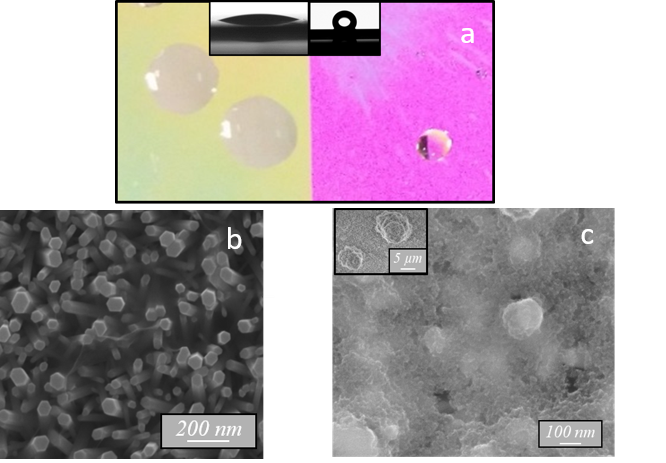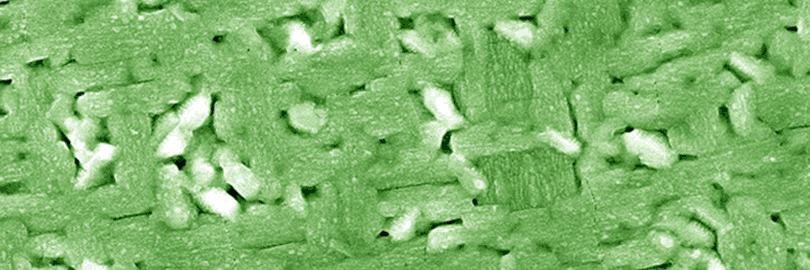Functionalization methods developed in this research line enable us to induce superhydrophilicity or superhydrophobicity on any surface. These approaches rely on sol-gel chemistry and hydrothermal synthesis, using inorganic materials (e.g. TiO2, SiO2 or ZnO) and hybrid organic-inorganic ones (e.g. hexadecyltrimethoxysilane). This skill is now exploited to develop new original approaches. For instance, a simplified photolithography method enables us to spatially control the surface wettability at the sub-millimetre scale. We also develop nanostructured composite membranes by infiltrating nanostructures with polymers. Such membrane may overcome the trade-off between permeability and selectivity, thus achieving highly efficient water purification while preventing biofouling on the membrane surfaces.

Wettability contrasts on a same surface (insets represent a side view of water droplets) (a), ZnO nanowires impregnated by polystyrene for membrane applications (b), persistent superhydrophobic surface inspired by the lotus leaf morphology (inset) (c).

Wettability contrasts on a same surface (insets represent a side view of water droplets) (a), ZnO nanowires impregnated by polystyrene for membrane applications (b), persistent superhydrophobic surface inspired by the lotus leaf morphology (inset) (c).
Contact
Main publications
- "Morphology-wettability relations in artificially structured superhydrophilic TiO2-SiO2 composite films", C. Holtzinger, B. Niparte, G. Berthomé, D. Riassetto, M. Langlet, J Mater Sci 48(8) (2013) 3107.
- "Superhydrophobic TiO2 coatings formed through a non-fluorinated wet chemistry route",
C. Holtzinger, B. Niparte, S. Wächter, G. Berthomé, D. Riassetto, M. Langlet, Surf Sci 617 (2013) 141.
- "Surface Functionalization by Sol-Gel Chemistry", D. Riassetto, C. Ternon, M. Langlet, 3rd World Congress and Expo on Nanotechnology, Singapour, 7-9 November 2016.
- "From Superhydrophilic to Superhydrophobic Surfaces", D. Riassetto, M. Langlet, C. Ternon, MRS Fall Meeting, 26 November-1December 2017, Boston, USA.
- "Superhydrophobic TiO2 coatings formed through a non-fluorinated wet chemistry route",
C. Holtzinger, B. Niparte, S. Wächter, G. Berthomé, D. Riassetto, M. Langlet, Surf Sci 617 (2013) 141.
- "Surface Functionalization by Sol-Gel Chemistry", D. Riassetto, C. Ternon, M. Langlet, 3rd World Congress and Expo on Nanotechnology, Singapour, 7-9 November 2016.
- "From Superhydrophilic to Superhydrophobic Surfaces", D. Riassetto, M. Langlet, C. Ternon, MRS Fall Meeting, 26 November-1December 2017, Boston, USA.



